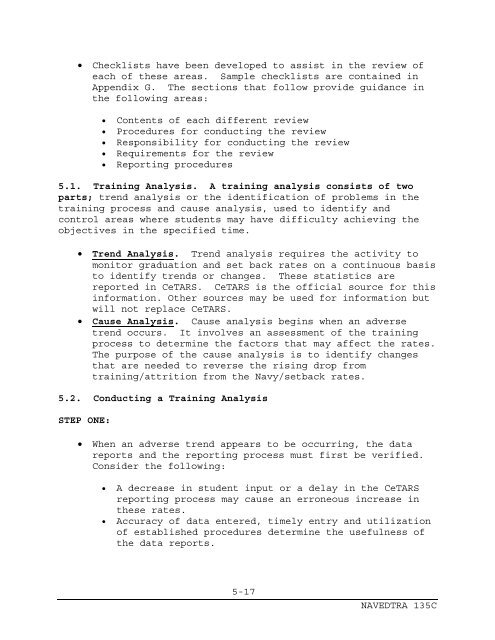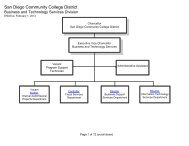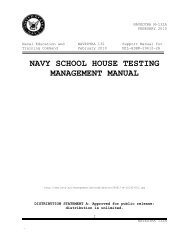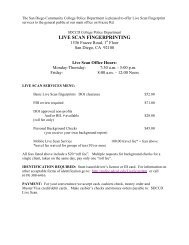NAVY SCHOOL MANAGEMENT MANUAL
NAVY SCHOOL MANAGEMENT MANUAL - AIM
NAVY SCHOOL MANAGEMENT MANUAL - AIM
- No tags were found...
You also want an ePaper? Increase the reach of your titles
YUMPU automatically turns print PDFs into web optimized ePapers that Google loves.
Checklists have been developed to assist in the review of<br />
each of these areas. Sample checklists are contained in<br />
Appendix G. The sections that follow provide guidance in<br />
the following areas:<br />
<br />
<br />
<br />
<br />
<br />
Contents of each different review<br />
Procedures for conducting the review<br />
Responsibility for conducting the review<br />
Requirements for the review<br />
Reporting procedures<br />
5.1. Training Analysis. A training analysis consists of two<br />
parts; trend analysis or the identification of problems in the<br />
training process and cause analysis, used to identify and<br />
control areas where students may have difficulty achieving the<br />
objectives in the specified time.<br />
<br />
<br />
Trend Analysis. Trend analysis requires the activity to<br />
monitor graduation and set back rates on a continuous basis<br />
to identify trends or changes. These statistics are<br />
reported in CeTARS. CeTARS is the official source for this<br />
information. Other sources may be used for information but<br />
will not replace CeTARS.<br />
Cause Analysis. Cause analysis begins when an adverse<br />
trend occurs. It involves an assessment of the training<br />
process to determine the factors that may affect the rates.<br />
The purpose of the cause analysis is to identify changes<br />
that are needed to reverse the rising drop from<br />
training/attrition from the Navy/setback rates.<br />
5.2. Conducting a Training Analysis<br />
STEP ONE:<br />
<br />
When an adverse trend appears to be occurring, the data<br />
reports and the reporting process must first be verified.<br />
Consider the following:<br />
<br />
<br />
A decrease in student input or a delay in the CeTARS<br />
reporting process may cause an erroneous increase in<br />
these rates.<br />
Accuracy of data entered, timely entry and utilization<br />
of established procedures determine the usefulness of<br />
the data reports.<br />
5-17<br />
NAVEDTRA 135C
















